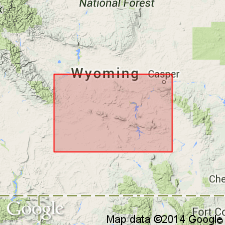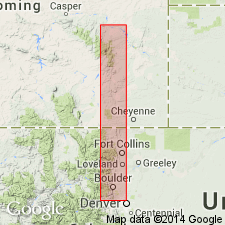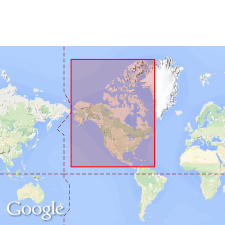
- Usage in publication:
-
- Pine Butte Member*
- Modifications:
-
- Named
- Dominant lithology:
-
- Sandstone
- Siltstone
- Shale
- AAPG geologic province:
-
- Green River basin
Summary:
Named as a member of Sundance Formation for Pine Butte, Carbon Co, WY in Greater Green River basin. Type section is at S1/2 sec 13, NW1/4 sec 14, T23N, R79W. Previously called member B of Sundance. Is equivalent to lower 30 ft of Redwater Shale Member of Sundance. Consists of greenish-white firmly lime-cemented sandstone with intercalated siltstone, grayish-green to olive-green papery clay shale. Glauconite present in sandstone and siltstone. The sandstone makes thin slabby ripple-marked ledges. The centrally furrowed fossilized trails made by crawling organisms are in the sandstones. The trails serve as a distinguishing feature of the member for separating Pine Butte from Redwater which has none. Intertongues with or grades down into underlying Lak Member of Sundance. Underlies Redwater Shale Member of Sundance. Of Jurassic age. Cross sections.
Source: GNU records (USGS DDS-6; Denver GNULEX).

- Usage in publication:
-
- Pine Butte Member*
- Modifications:
-
- Areal extent
- AAPG geologic province:
-
- Powder River basin
- Denver basin
Summary:
As the middle member of Jurassic Sundance Formation, overlies Canyon Springs Sandstone Member, and unconformably underlies Windy Hill Member of Sundance from Horse Creek, Laramie Co, WY south to a few miles just north of Four Mile Canyon, Boulder Co, CO in Denver basin. North of Horse Creek to the Powder River basin near Douglas, Converse Co, WY, Powder River basin, is one of seven members of Sundance. Measured sections shown graphically.
Source: GNU records (USGS DDS-6; Denver GNULEX).

- Usage in publication:
-
- Pine Butte Member*
- Modifications:
-
- Revised
- Overview
- Areal extent
- AAPG geologic province:
-
- Williston basin
- Chadron arch
- Powder River basin
Summary:
Pine Butte Member of Sundance Formation recognized and described as mostly greenish-gray and yellowish-gray, locally glauconitic sandstone, 32 ft thick, in standard [Principal] reference section of Sundance Formation, SE1/4 sec 3, T7N, R2E, Lawrence Co, SD southern Williston basin. Revised--previously included in the basal part of Redwater Shale Member in the Black Hills region. Recognized elsewhere in Black Hills region in Crook and Weston Cos, WY (eastern Powder River basin) and in Fall River Co, SD (northwestern Chadron arch). Conformably overlies Lak Member; unconformably overlain by Redwater Shale Member (revised). Is Middle Jurassic (Callovian) in age. Summarizes lithology, basis for dating, distribution, and correlation.
Source: GNU records (USGS DDS-6; Denver GNULEX).
For more information, please contact Nancy Stamm, Geologic Names Committee Secretary.
Asterisk (*) indicates published by U.S. Geological Survey authors.
"No current usage" (†) implies that a name has been abandoned or has fallen into disuse. Former usage and, if known, replacement name given in parentheses ( ).
Slash (/) indicates name conflicts with nomenclatural guidelines (CSN, 1933; ACSN, 1961, 1970; NACSN, 1983, 2005, 2021). May be explained within brackets ([ ]).

